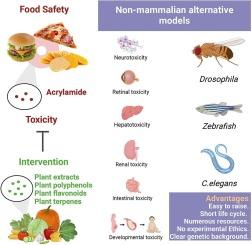当前位置:
X-MOL 学术
›
Food Chem.
›
论文详情
Our official English website, www.x-mol.net, welcomes your
feedback! (Note: you will need to create a separate account there.)
Utilizing alternative in vivo animal models for food safety and toxicity: A focus on thermal process contaminant acrylamide
Food Chemistry ( IF 8.5 ) Pub Date : 2024-11-19 , DOI: 10.1016/j.foodchem.2024.142135 Yang Cai, Yuhan Wang, Yanfei He, Kefeng Ren, Zongzhong Liu, Lingli Zhao, Tian Wei
Food Chemistry ( IF 8.5 ) Pub Date : 2024-11-19 , DOI: 10.1016/j.foodchem.2024.142135 Yang Cai, Yuhan Wang, Yanfei He, Kefeng Ren, Zongzhong Liu, Lingli Zhao, Tian Wei

|
Rodent models have traditionally been used to assess the toxicity of food chemicals, but this approach is costly, time-consuming, and raises ethical concerns. Alternatively, non-mammalian models such as Drosophila melanogaster, Danio rerio, and Caenorhabditis elegans have been shown to be suitable for studying the toxicity of food hazards. Their advantages include low cost, short life cycles, adaptability to high-throughput screening, and adherence to the 3R principles of replacement, reduction, and refinement. These models have been extensively studied in the context of acrylamide toxicity, a common food contaminant. This article comprehensively reviews the biological characteristics of non-mammalian models, recent advances and challenges in acrylamide toxicity research using these models, and explores the potential of natural plant compounds in ameliorating acrylamide toxicity. The review aims to guide research using non-mammalian models for food safety assessment.
中文翻译:

利用替代体内动物模型进行食品安全和毒性分析:关注热过程污染物丙烯酰胺
传统上,啮齿动物模型用于评估食品化学品的毒性,但这种方法成本高昂、耗时,并且会引发道德问题。或者,非哺乳动物模型,如黑腹果蝇、Danio rerio 和秀丽隐杆线虫已被证明适合研究食物危害的毒性。它们的优点包括成本低、生命周期短、适应性强、可适应高通量筛选,并遵守替代、还原和精炼的 3R 原则。这些模型已在丙烯酰胺毒性(一种常见的食品污染物)的背景下进行了广泛的研究。本文全面综述了非哺乳动物模型的生物学特性、使用这些模型进行丙烯酰胺毒性研究的最新进展和挑战,并探讨了天然植物化合物在改善丙烯酰胺毒性方面的潜力。本综述旨在指导使用非哺乳动物模型进行食品安全评估的研究。
更新日期:2024-11-19
中文翻译:

利用替代体内动物模型进行食品安全和毒性分析:关注热过程污染物丙烯酰胺
传统上,啮齿动物模型用于评估食品化学品的毒性,但这种方法成本高昂、耗时,并且会引发道德问题。或者,非哺乳动物模型,如黑腹果蝇、Danio rerio 和秀丽隐杆线虫已被证明适合研究食物危害的毒性。它们的优点包括成本低、生命周期短、适应性强、可适应高通量筛选,并遵守替代、还原和精炼的 3R 原则。这些模型已在丙烯酰胺毒性(一种常见的食品污染物)的背景下进行了广泛的研究。本文全面综述了非哺乳动物模型的生物学特性、使用这些模型进行丙烯酰胺毒性研究的最新进展和挑战,并探讨了天然植物化合物在改善丙烯酰胺毒性方面的潜力。本综述旨在指导使用非哺乳动物模型进行食品安全评估的研究。


















































 京公网安备 11010802027423号
京公网安备 11010802027423号